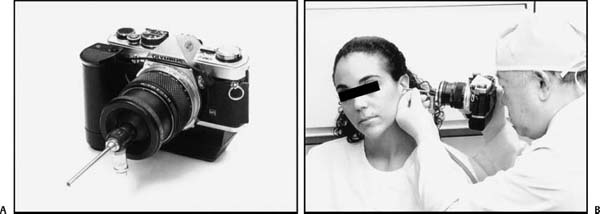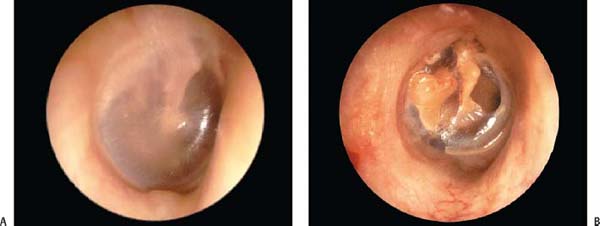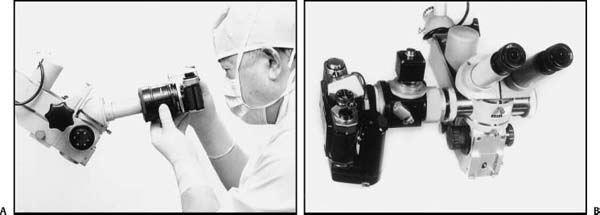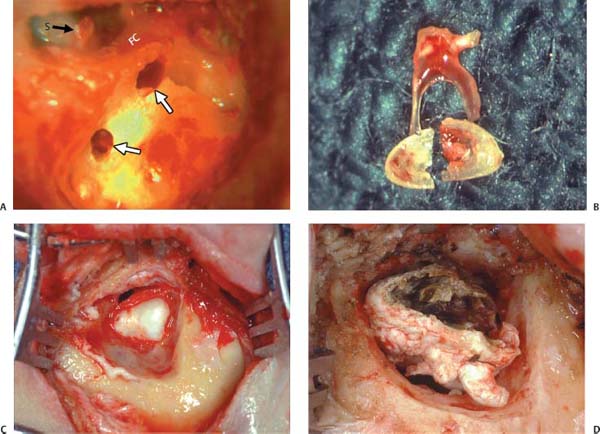12
Otologic Photography and Videography
Eiji Yanagisawa and Ken Yanagisawa
The first American photographic documentation of the tympanic membrane1 occurred in 1887 when Randall and Morse2 published a series of normal and pathologic images of the tympanic membrane. Since that time, many different methods of tympanic membrane photography have evolved.3–16 Open tube photography was popularized using a variety of different cameras including the Cameron, Brubaker-Holinger, and Kowa.3–6 Buckingham3 first adapted the Brubaker-Holinger camera to ear photography in the mid-1950s, and produced beautiful, high-quality images of the tympanic membrane and middle ear. Smith et al6 described an inexpensive method of producing high-resolution images of the tympanic membrane using a Kowa Fundus camera. Both of these methods produced small images that required editing and enlargement to be appreciated when projected. The introduction of the Carl Zeiss operating microscope in the late 1950s made it feasible to obtain enlarged images of the tympanic membrane. A variety of attachments was subsequently created that permitted 35mm and video cameras to document images via photo adapters.8,9 An alternative, less expensive method of photographing the tympanic membrane through the eyepiece of the microscope with a 35 mm single lens reflex (SLR) camera was described by Hughes et al7 and Yanagisawa et al.8
The development of the Hopkins telescope was a significant advancement in endoscopic technology.8–15 Rather than air-containing spaces between conventional lenses, glass rods with polished ends separated by small air lenses were used, greatly improving image quality, brightness, and magnification. Many clinicians including Konrad et al,10 Chen et al,11 Chole,12 Nomura,13 Yanagisawa,8 and Hawke14 have refined the techniques for improving the quality of images captured with the telescope. Several excellent textbooks of telescopic tympanic membrane photography have been published.17–21 Selkin16 has recommended fiberscopic photography as an alternative means to capture images of the tympanic membrane. Transtympanic endoscopy of the middle ear was pioneered by Nomura13 in 1982 and advocated by Poe et al22 as an office procedure to precede middle ear exploration using a 2-mm or smaller telescope by which they could take acceptable pictures of the middle ear structure.
With the advent of video cameras, Yanagisawa extensively used videography23–26 as an ideal method for endoscopic documentation because it provides a real-time record of anatomic structures and their movements, and allows instantaneous review, confirming adequate image capture. He advocated the wider use of videography and video printers in otolaryngology.23–27 Excellent still images could be produced from videotapes using an analog video printer.23–28
We are now in the era of digital imaging.29,30 There are currently several newer digital image capture systems. One of us (E.Y.) had the opportunity to use one of these systems, the Stryker Digital Capture System (SDCS; Kalamazoo, MI) and found it to be very effective and promising. It is a device that quickly transports surgical images to a high-density computer disk. Image capture time is very fast, taking approximately 1 second. Stored images can be viewed, selected, and easily retrieved. It costs approximately $11,000.30
With the widespread use of still digital cameras, their use in otorhinolaryngologic endoscopy has been recommended.30–34 Melder and Mair31 compared an off-the-shelf digital camera with a standard single lens reflex 35 mm endoscopic camera and introduced a simple, inexpensive, and easily available endoscopic digital photography system. They stated that digital photography offers numerous advantages over analog photography. They predicted digital imaging would soon replace 35 mm camera photography.
Haynes et al34 described the microscopic photographic technique with the handheld digital camera placed in contact with one of the microscope ocular lenses. Using this practical and inexpensive technique, it was possible to take beautiful pictures of a variety of microsurgical procedures through the eyepiece of the microscope.
This chapter discusses traditional (film) photography, digital (filmless) photography, and videography of the ear.
 Traditional (Film) Photography
Traditional (Film) Photography
Telescopic Film Photography
A majority of the tympanic membrane pictures shown in this book were taken with a Hopkins 4.0 mm telescope (Karl Storz 1215A, Culver City, CA) attached to an Olympus OM2 SLR camera with a 100-mm Zuiko lens (Fig. 12–1A). The 1–9 focusing camera screen and the autowinder were used. For the light source, Karl Storz flash generator (No. 558) was used. The distance of the lens of the camera was set at infinity and the shutter speed at 1/30 second. The intensity dial of the flash generator was set at 1. Best results were obtained with the aperture set at f/5.6 when Ektachrome Daylight film ASA 200 was used.

Figure 12–1 Telescopic film photography of the ear. (A) Equipment recommended for telescopic film photography includes the Olympus OM2 SLR 35 mm camera with autowinder, the 100-mm macrolens, the Karl Storz quick-connect adapter, and the Hopkins 4 mm 0-degree 1215A ototelescope. (B) The technique of telescopic film photography. An Olympus OM-2 SLR camera with a Hopkins 4 mm 0-degree 1215A ototelescope is held in one hand while the tip of the telescope and the head of the patient is supported by the other hand to prevent injury to the ear canal.
In this technique, the 4 mm telescope attached to the Olympus OM2 SLR camera is carefully inserted into the ear canal while the camera is held in one hand and the tip of the telescope and the head of the patient are supported by the other hand to prevent injury to the ear canal and the tympanic membrane (Fig. 12–1B).
The authors have also used a nonflash technique with a Nikon N8008 camera with the 55-mm Nikkor lens and 2X teleconverter. The camera was set at the automatic mode and f-stop at 5.6. The Karl Storz light source 610 was used.

Figure 12–2 Telescopic film photography of the ear. (A) Normal right tympanic membrane. (B) Right postoperative tympanoplasty with incus repositioning.
The advantages of the telescopic technique include the following: (1) The entire tympanic membrane can be visualized, because the tip of the telescope can be passed through the narrow isthmus of the ear canal (Fig. 12–2). This is not the case in the microscopic techniques. (2) The wide-angle view of the telescope allows an almost infinite depth of field, so that all areas of the tympanic membrane are in focus. (3) No cropping or enlargement is required when the finished slides return from the processing laboratory. Using the 100-mm lens, the diameter of the image measures 21 mm on the finished slide.
The disadvantages of the telescopic technique include the following: (1) Lens fogging can be annoying, and frequent dips into warm water or anti-fog solution are needed. (2) Care must be taken not to touch the ear canal or the tympanic membrane. We recommend holding the camera in the right hand and grasping the telescope several centimeters from the tip in the left hand to stabilize the scope as well as to prevent excessive length from sliding into the ear canal (Fig. 12–1B). A pediatric patient is placed in the supine position with the head held steady by an assistant.
Microscopic Film Photography
Using the Zeiss operating microscope with a 250-mm lens, 35 mm still photographs can be taken with a SLR camera with or without a photoadapter.
Microscopic Film Photography Through the Eyepiece of the Microscope (Without a Photoadapter)
Microscopic photography through the eyepiece of the microscope using a 35 mm SLR camera without a photoadapter8,9 requires the following equipment: (1) 35 mm SLR camera such as Olympus OM2 or Nikon 8008, with a 50-mm macrolens (“aperture-preferred” mode); (2) Ektachrome tungsten film ASA 320 (Fig. 12–3A).
With the eyepiece of the microscope set at 0, the tympanic membrane image is viewed through the microscope, centered, and focused. The focus on the camera is set at infinity with the aperture open maximally (typically f-3.5). The macrolens of the camera is placed gently but snugly against the eyepiece (Fig. 12–3A). The tympanic membrane is centered and photographs are taken.
The advantages of this technique include the following: (1) The technique is easy and simple to perform. (2) If you own a SLR camera and a macrolens, the technique is inexpensive. (3) Magnification changes can be made through the microscope. Surprisingly good pictures can be taken using this inexpensive technique (Fig. 12–4A,B).
The disadvantages of this technique include the following: (1) It may be difficult to hold the camera perfectly still on the microscope eyepiece. (2) Medical procedures must be interrupted to take the photograph. (3) Bright illumination is required or a film with high speed/high ASA rating (ASA 160 pushed to 320 or ASA 320 film).

Figure 12–3 Microscopic still photography of the ear. (A) Technique of microscopic film photography through the eyepiece of the microscope without photoadapter. Recessed housing of the macrolens of an SLR camera is held against the eyepiece of the microscope. Make sure the optical line of the microscope and the camera is straight. The tympanic membrane is focused through the camera viewfinder and photographs are taken. (B) The technique of microscopic film photography with a photoadapter. The SLR camera is attached to the operating microscope using the photoadapter and the beam splitter. The subject is focused through the camera viewfinder and photographs are taken.
Microscopic Film Photography with a Photoadapter
Microscopic photography using an SLR camera with a photoadapter requires the following equipment: (1) a Zeiss operating microscope; (2) a Zeiss beam splitter; (3) a photoadapter, such as Zeiss TV photoadapter, Zeiss-Urban dual adapter, or Design for Vision adapter (Storz Instruments, St. Louis, MO) (Fig. 12–3B); (4) an adapter ring for the SLR camera; (5) an automatic 35 mm SLR camera such as an Olympus OM2 or Nikon 8008; and (6) Ektachrome film ASA 400. The image is identified, centered, and focused through the operating microscope. Magnification is selected to best demonstrate the otologic findings. The camera is attached to a side arm via the beam splitter and photoadapter (Fig. 12–3B). It is set on automatic mode, and selected photographs are taken by depressing the shutter release button. Bracketing of exposures both under and over is recommended.
The advantages of this technique include the following: (1) The camera is steady. (2) The procedure is not interrupted. (3) Different magnifications of the microscope are readily available. (4) Simultaneous video and still photography can be performed if appropriate television still photoadapters are used. This is a more dependable technique of photography because the camera is fixed (Fig. 12–4C,D).
The disadvantages of this technique include the following: (1) The photo-adapter and beam splitter are expensive. (2) An adapter ring for SLR camera is needed.
 Digital Photography (Filmless Photography)
Digital Photography (Filmless Photography)
Digital imaging is the newest technology for permanently recording images without film or videotape. An image obtained via a video camera is converted to an electronic signal that a computer can read, record, and store in a digital fashion.30
There are three primary approaches to creating digital images. The first is to convert a photograph or slide into a still digital image using an image scanner connected to a computer. The second is to convert an analog signal from a video camera or videotape into streaming digital video with an image capture board installed in a computer. Such hardware is universally compatible with either a Macintosh- or a PC-based system. Using this method, the senior author has produced excellent images for his publications.23–27 He uses ¾-inch prerecorded videotapes, a Macintosh computer, Avid Media Suite Pro video editing software, Adobe Photoshop, and a Sony digital dye-sublimation printer. Several easy and useful video editing applications are commercially available such as that by Pinnacle studio (Mountain View, CA). The third is to capture the image directly with a charge-coupled device (CCD) digital camera. This method bypasses conversion and starts with a digital image at the time of capture. Components of a digital imaging system include a digital camera, computer, removable memory storage, digital video recorder, and color digital printer.

Figure 12–4 Microscopic film photography through the eyepiece of the microscope without a photoadapter. (A) Left mastoid cavity with opened horizontal semicircular canal (arrows) during labyrinthectomy. S, stapes; FC, facial canal. (B) Otosclerotic stapes removed during total stapedectomy. Microscopic film photography with a photoadapter. (C) Cholesteatoma filling the medial portion of the left mastoid cavity. (D) Large cholesteatoma filling the left mastoid cavity.
Stay updated, free articles. Join our Telegram channel

Full access? Get Clinical Tree


